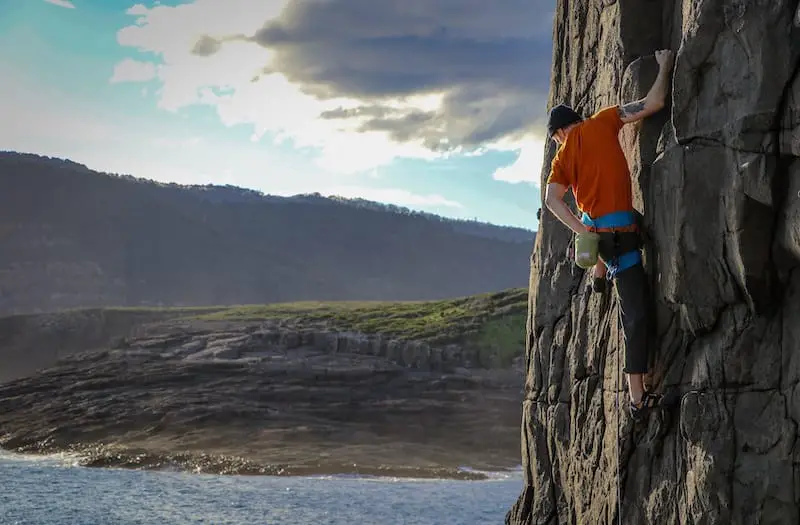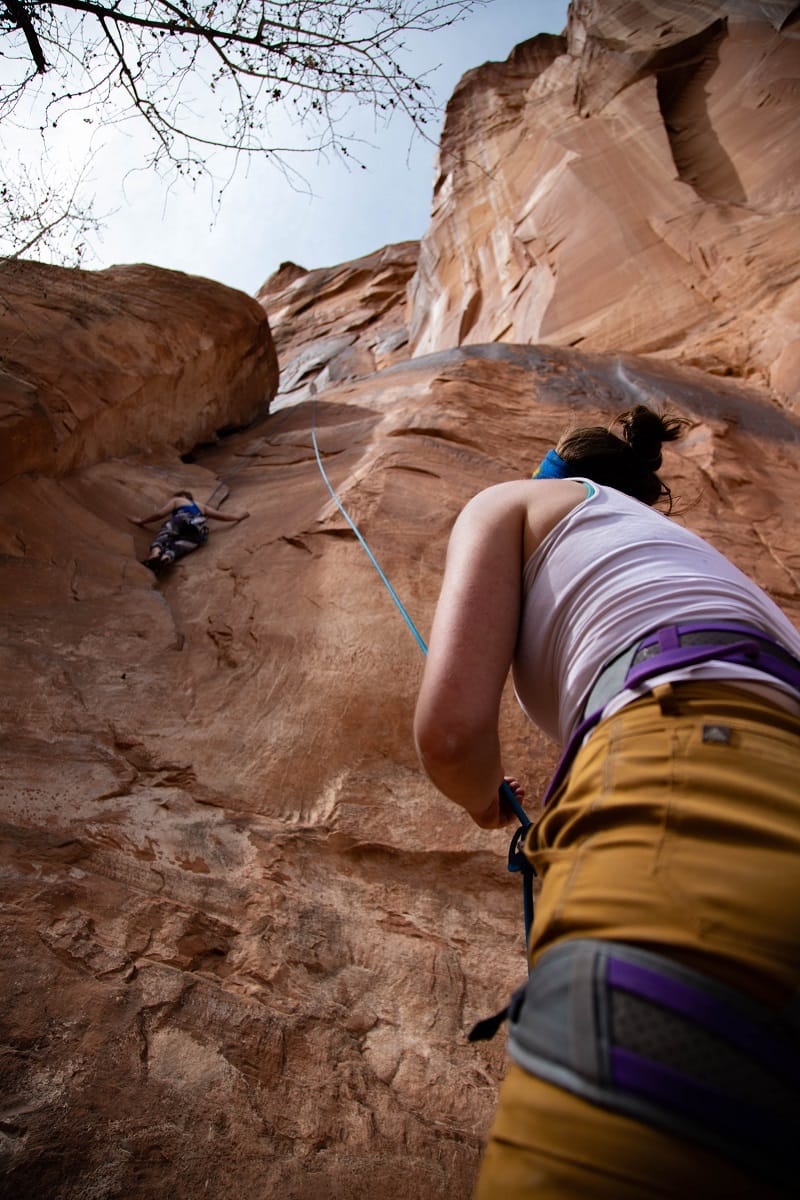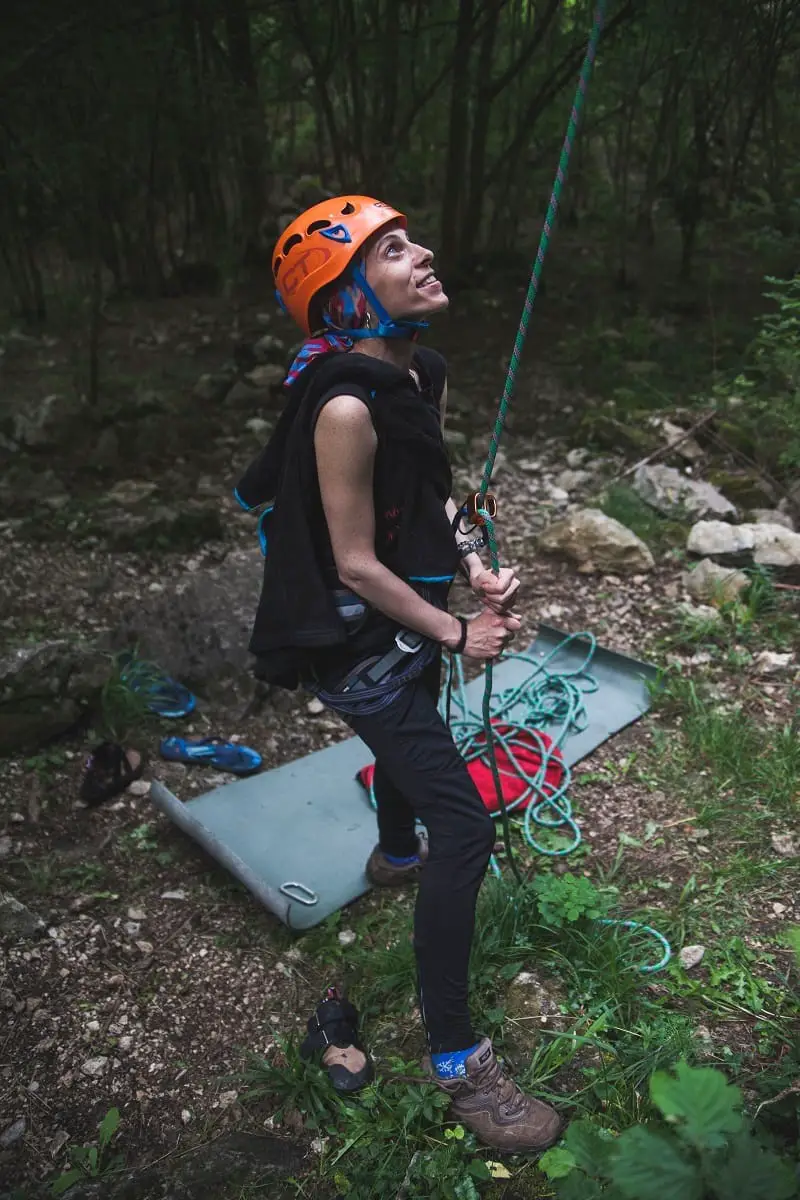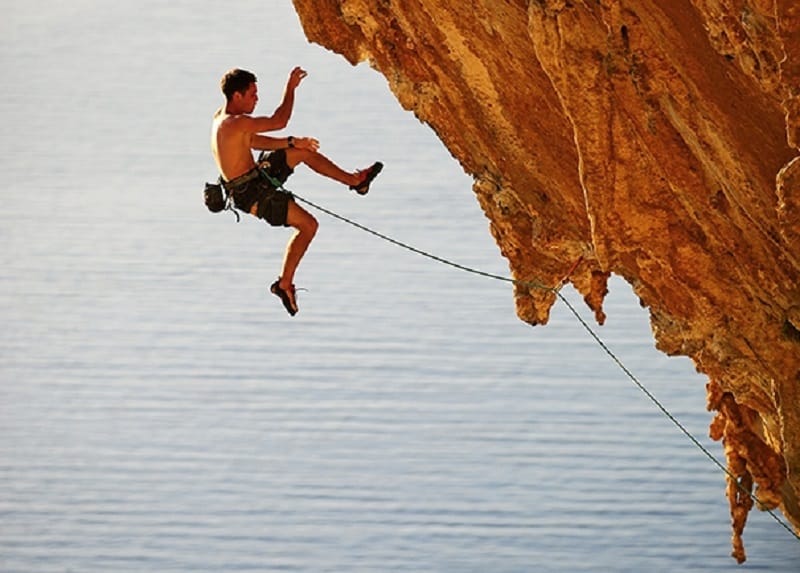Oh the places you will go
Rummaging around the back of your van, you find part of a sandwich. Doesn’t smell that weird.
Down the hatch.
An hour passes and you’re snapped into a feverish vision:
It’s blaring sun on a ridgeline at the base of a climb. Two climbers appear, though you can’t make out their faces. One is ruggedly attractive with some powerful sending tights.
Over the sound of the wind, you catch a few sentences from the dapper one:
“Gonna lead or TR?”
“What’s the anchor like? Does it need gear?”
“Can you clean it?”
Snap back to reality.
What does it all mean?
Dive in to find out……..
Top Rope (TR) Climbing, Top Roping
Desert TR love
The classic.
The journey begins, and often revisits, here. You will be Top Roping (TRing) from the first time you slide your legs into that crispy new harness in the gym until the day you decide you’ve donated enough finger skin to the rock gods and take up watercolor.
Grow that afro.
The technique is in the name on this one. In Top Roping, the rope comes from the top (through the anchor) and back down to you. The rope is always pulling up from your harness.
Top roping is the reason for all the ropes hanging from the rafters of your local gym. Top down to you.
This may cause you to ponder, “Hmmmm. How, pray tell, doth one proceed in the charge of raising thine rope to the aforementioned anchor, outdoors?”
I like the way you asked that.
This is where lead climbing (leading) comes into the fray.
Fall Risk
Some TR technique. Watch the amount of rope stretch when falling.
Minimal. Very minimal.
However, anyone who tells you it’s zero is not giving you the whole picture.
Reason being, you will likely be using a dynamic rope. Dynamic ropes stretch.
That’s part of their charm. It makes the catches less jarring.
For comparison, think how lovely even a foot fall onto a steel cable would be.
Whiplashy.
What this means for you, is the earlier in the route you are, the more rope stretch there is.
Envision it like this.
If you were to grab a hair tie (you lovely, flowing hippie, you) with both hands close together and stretch the hair tie, not much distance change. Now grab at either end and pull. Way more stretch.
Same for a rope. When you’re at the start of a TR climb, your rope goes from your belayer to the anchor and back to you.
That’s double the length of the route.
As you climb up, the belay takes in the slack, lessening the rope in the system.
Now, when I say rope stretch and fall, I don’t mean they will be catastrophically huge.
A handful of feet if you fall close to the ground on a long climb, dependent on your weight.
Not a big danger but don’t be shocked if it happens.
Gear Required
ATC? Check. Harness? Check. Helmet? Check. Rope? Check. Ready for takeoff.
Not much.
This the sandals of the rope climbing world.
If you aren’t setting the anchor or cleaning it, only climbing, you will only need:
- Climbing shoes (not even necessary but waaaaaay more enjoyable)
- Climbing helmet (not indoors, debatable outdoors)
- Harness
- Belay device, for when your partner gets a turn
That’s it.
When the onus of cleaning the route falls on your shoulders, you’ll generally need a personal anchor system as well.
This often takes the shape of a 120 cm sling. These are colloquially called double length slings as they must be wrapped around your chest twice, like a sash, to fit.
You may also use a PAS, a length of cordelette joined with a double fisherman’s knot, or a variety of other manufactured products. My personal favorite is about 10 feet of cord, joined together, with a Purcell prusik tied for adjustability.
How to tie a Purcell prusik
Take your pick. All systems will require a locking carabiner.
If you are the one putting up the climb, you’ll need the same and a bit more:
- The ability to make a safe anchor. For bolted anchors, I recommend the quad
- Climbing rope
- Anchor material (see “safe anchor” above)
- Quickdraws or trad gear (for leading the climb if it can’t be accessed from the top)
Skills Needed
Wonderful demonstration on anchor cleaning.
If you are the climber and the rope is at the top already, you just need to know how to tie in and how to TR belay.
Cleaning the route may fall on your shoulders.
If you are setting the anchor with top access, you will need to know how to build a good anchor (here and the beginning of the cleaning video).
As always, practice your skills on the ground and have them verified by someone knowledgeable. It’s incredibly dangerous to figure this stuff out on route.
Lead Climbing
Spice lord taking down a roof.
When you go into your local Thai restaurant and decide “Today is the day I try the #4 curry.”
Zesty.
It’s the same climb as TRing. The difference between top rope is in the name.
The rope isn’t above you in an anchor.
You “lead” the rope up with you. You tie into the end of the rope and climb up placing protection (pro) along the way.
If you are sport climbing, you will be clipping quickdraws into bolts. This is what’s seen in gyms.
Trad climbing takes a different approach, using cams and stoppers to protect the climb. In this style, nothing is drilled into the wall prior. All the protection (also called gear) is provided by you.
Visit here for all the information you need to the technique of leading.
Fall Risk
Climber go zoom
Greater than TRing.
Imagine you are rock climbing and are 5 feet above your last piece of pro. Meaning, there’s 5 feet of rope above the gear.
A fall here is 10 feet plus rope stretch. The first 5 for the distance of you to the gear, the second 5 because you have 5 feet of rope out past the gear.
Oftentimes, the falls will be in open space without consequence, called clean falls.
However, you must weigh the risks of the difficulty of the climb, where there is protection, and if the falls are risky (ledges below etc.).
Gear Required
Racking up for some sweeeeeet delight
Depends on the discipline. As stated above, lead climbing is separated into 2 disciplines: sport and trad.
With both styles, you must have all the gear to set the anchor for a TR climb (see Gear Required for putting up a TR above).
In sport climbing, you will need quickdraws. Each climb is different, but usually 12 quickdraws is enough to do most things.
In trad, you’ll need a rack. This is usually alpine draws, stoppers, and cams.
Skills Needed
Lead belaying tips. Make sure to practice before you play.
All the same as in top rope climbing plus a bit extra.
The style of belaying changes as the belayer spends the majority of their time giving the climber slack. This differs from the TR setting where slack is only ever taken in.
When leading, you must know how to clip draws (sport) or place gear (trad).
Clipping quickdraws. Sport climbing skill.
When you get into trad climbing, there is no replacement for learning in-person. This is especially important as your safety is entirely dependent on how well you place and assess gear.
Top Roping vs Lead Climbing: Similarities
Both TRing and leading climb the same route. Same positions. Same movement.
Both require a belayer, rope, and some kind of anchor.
Depending on the climb, you may need to clean anchors in both.
Top Roping vs Lead Climbing: Differences
One of many great videos about conquering, or living with, the fear of falling
The risk of fall is significantly greater in lead climbing.
Note this important point.
Just because there’s a greater risk you might fall doesn’t mean falling is risky.
It can be. Falling is not inherently risky. Plenty of falls are into open space with no risk of injury.
Generally, lead climbing necessitates more fear control for that reason.
Lead climbing requires the knowledge to place and clip the rope into some kind of protection.
Belaying is very similar in both instances. It’s usually very easy to go from competent TR belayer to lead belayer. Very similar positions and techniques.
That being said, lead belaying is slightly more advanced and must be taken seriously.
Which Should You Learn First?
Top rope.
There’s less to juggle in your mind. It’s easy to start in a gym.
Start with the simple and ease your way in.
Follow Your Path
I want to give this quick note.
There is a definite culture of boldness in climbing.
While this environment can be incredibly motivating, it can also look down on styles with less perceived risk. Top Rope climbing.
Know this:
Regardless what culture will tell you, all climbing is rad, chill or otherwise.
Pushing yourself is rad.
If you’ve been climbing for years and pushing yourself looks like leading steep climbs on marginal gear, great.
If you are petrified of heights and manage to get 5 feet off the ground on TR, battling what every fiber of your being says, that’s a triumph.
Measure yourself by where you are. Don’t let anyone tell you that your form of trying isn’t as good as there’s. It’s the same.
Try hard. Have fun. Do the style of climbing you want. You’re doing wonderfully.
Fear in Top Roping and Lead Climbing
Outside the scope of this article, is the management of fear. This will come in handy, bigtime, for leading.
Alex Honnold and Arno Ilgner talk about fear. Two masters. Dive in!
Check out these books for resources:
- The Rock Warrior’s Way by Arno Ilgner
- Vertical Mind
You snap back in.
The light fades from the climbers’ faces and they become clear.
The one with the great fashion and tons of rock knowledge… Why, it’s you!
What a crusher you’ve become.
We’ve gone on quite the journey.
Now go forth and send.
For more reading see: “What Is Bouldering? Absolutely Everything You Need To Know”

Cheap date with an expensive rack. I’ve traveled, lived, across our beautiful globe, with Guatemala holding a special place en mí corazón. Been doing this for years and made every possible mistake along the way so you don’t have to. I’ve worked the last few summers as a Climbing Instructor for Avid4 Adventure, ushering in the next generation of crushers. I’ve got a physics degree. One day I’ll be able to shoehorn in the spacetime continuum into an article about chalk bags. I enjoy long walks at the crag underneath the light of a headlamp. Nothing gives me more joy than serenading you all with climbing and gear knowledge. Much love. Mwah.






